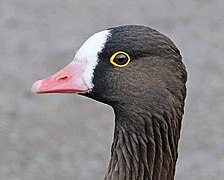Oční kroužek

Oční kroužek, též očnicový kroužek či oční okruží, je kruhovitá linka kolem očí ptáků, která může být opeřená (např. kruhoočkovití) nebo neopeřená (tzn. kroužek holé kůže, např. holubi).[1] U některých ptáků se jedná o výrazný rozpoznávací znak.[2] Kroužky mohou být různých barev i tlouštěk od velmi úzkého tenkého proužku s jednou řadou peříček, které jsou v terénu sotva viditelné, po široké dominantní kruhy. Někdy oční kroužek nemusí být po celé délce stejně zabarven, ale může být před a za okem tmavý, zatímco části nad a pod okem mají světlejší barvu, takže tvoří malé obloučky.[2]
Oční kroužky patrně slouží k přenosu informace mezi jednotlivci. Mohou být např. nositelem informace o zdravotním stavu, resp. biologické zdatnosti jedince.[1] Např. u orebice rudé bylo zjištěno, že její rudý zobák a rudý oční kroužek slouží jako indikátor tělesné zdatnosti. Zbarvení očního kroužku i zobáku je totiž způsobeno karotenoidovým přírodním barvivem, které si obratlovci neumí sami vyrobit a je potřeba ho získat skrze potravu. Vedle tělesné zdatnosti tak sytost zobáku a očního kroužku orebice vypovídá i o nedávném nabytí tělesné hmotnosti.[3]
Galerie
- Drozdíci mají kolem očí dvojitý kroužek miniaturních peříček
- ouhorlík indomalajský s kompletním, avšak pouze částečně kontrastním očním kroužkem
- Výrazný červený oční kroužek u kulíka rezavoocasého
- Sytě žlutý oční kroužek husy malé
- Kakadu brýlový má kolem očí nápadný modrý neopeřený oční kroužek
- Světlé oční obloučky lesňáčka křovištního
Odkazy
Reference
- ↑ a b FILARDI, Chris. Answering Questions About Island Species [online]. The New York Times, 2011-02-25. Dostupné online. (anglicky)
- ↑ a b SIBLEY, David. David Sibley explains eye-rings. BirdWatching [online]. [cit. 2022-12-05]. Dostupné online. (anglicky)
- ↑ PÉREZ-RODRÍGUEZ, Lorenzo; VIÑUELA, Javier. Carotenoid-based bill and eye ring coloration as honest signals of condition: an experimental test in the red-legged partridge (Alectoris rufa). S. 821–830. Naturwissenschaften [online]. 2008-09 [cit. 2022-12-05]. Roč. 95, čís. 9, s. 821–830. DOI 10.1007/s00114-008-0389-5. (anglicky)
Externí odkazy
 Obrázky, zvuky či videa k tématu oční kroužek na Wikimedia Commons
Obrázky, zvuky či videa k tématu oční kroužek na Wikimedia Commons
Média použitá na této stránce
Autor: Ross Elliott, Licence: CC BY 2.0
A Lesser White-fronted Goose at WWT Slimbridge, Gloucestershire, England.
Autor: Tobias, Licence: CC BY-SA 2.0
Blue-eyed Cockatoo at Walsrode Bird Park, Germany.
Autor: NTox, Licence: CC BY-SA 3.0
View of a Killdeer's head. The bird was protecting its offspring in Minnesota, United States.
Autor: Bernard Spragg. NZ from Christchurch, New Zealand, Licence: CC0
The silvereye – also known as the wax-eye, or sometimes white eye – is a small and friendly olive green forest bird with white rings around its eyes. Silvereye (Zosterops lateralis) were self introduced in the 1800s and now have a wide distribution throughout New Zealand. They have made the forest their home and are now among the most common bird in suburbia too. The silvereye has a wide distribution throughout New Zealand. They can be found from sea level to above the tree line but they are not abundant in deep forest or open grassland. Slightly smaller than a sparrow, the silvereye is olive-green with a ring of white feathers around the eye. Males have slightly brighter plumage than females. They have a fine tapered bill and a brush tipped tongue like the tui and bellbird.
Silvereyes mainly eat insects, fruit and nectar.Autor: JJ Harrison (jjharrison89@facebook.com), Licence: CC BY-SA 3.0
Oriental Pratincole (Glareola maldivarum), Beung Borapet, Nahkon Sawan, Thailand
Autor: JMK, Licence: CC BY-SA 3.0
Close-up of a juvenile Cape Robin in suburban Pretoria, South Africa. The eye-ring is conspicuous in the juvenile, while in the adult it is blackish and merges with the face plumage. The white supercilium of an adult is prominent, though still inconspicuous in this juvenile.
Autor: Caleb Putnam, Licence: CC BY 2.0
MacGillivray's Warbler Geothlypis tolmiei, Hungry Horse, Montana.












